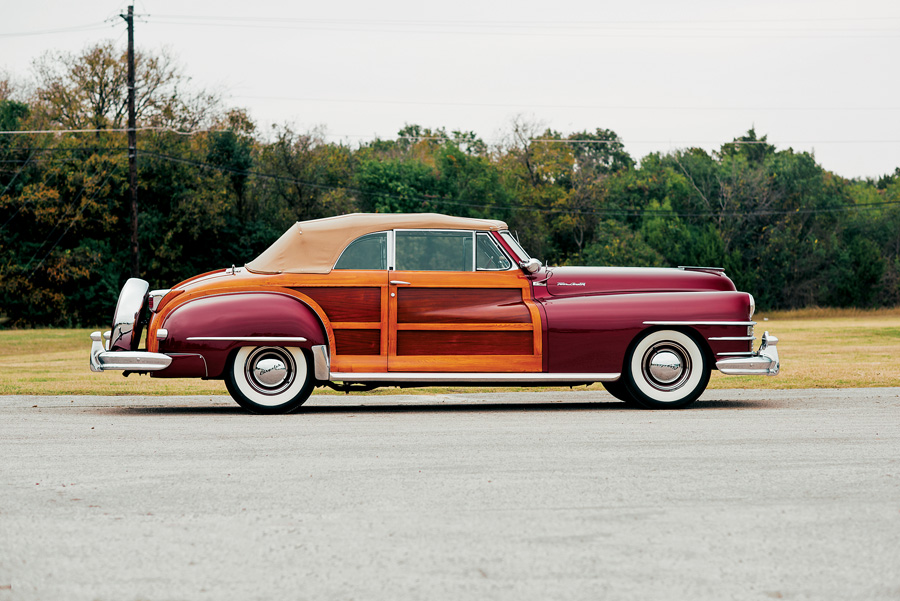SCM Analysis
Detailing
| Vehicle: | 1946 Chrysler Town & Country convertible |
| Years Produced: | 1946–48 |
| Number Produced: | 8,373 convertibles (all years) |
| Original List Price: | $2,725–$3,430 |
| SCM Valuation: | Median to date, $132,000 |
| Tune Up Cost: | $200 |
| Distributor Caps: | $35 |
| Chassis Number Location: | Left front door hinge |
| Engine Number Location: | Left side of block between cylinders 1 and 2 |
| Club Info: | National Woodie Club, CCCA |
| Website: | http://www.nationalwoodieclub.com |
| Alternatives: | 1946–48 Ford Sportsman, 1940–47 Cadillac 60 Special convertible, 1937 Cord 812 phaeton |
| Investment Grade: | B |
This car, Lot 51, sold for $79,750, including buyer’s premium, at the Bonhams auction in Scottsdale, AZ, held January 19–20, 2017.
The Chrysler Town & Country was developed in 1940 as a streamlined station wagon. It was a 4-door, 8-passenger wagon based on the Chrysler Windsor, with white ash framework and Honduras mahogany paneling. The roof was from the Chrysler Imperial, and “barrel back” doors were an identifying feature. It was a striking alternative to the boxy and awkward offerings of the era.
David Wallace was the president of Chrysler at the time, but he also served as the president of Perkins Wood Products, which supplied wood boxes, crates, and other products to Chrysler for years — as well as paneling for the woodies. Of course, that was a potential conflict of interest that just might raise a few eyebrows in today’s world.
A total of 1,997 Town & Countrys — so called because “the front looked ‘town’ and the rear looked ‘country’” — were built in 1941–42 prior to production shifting to the war effort. The most unusual was the 1942 “Laura A,” a Town & Country wagon that was converted by Bohman and Schwartz to an open 4-door touring car. It appeared in numerous Hollywood films but its whereabouts are currently unknown.
Varnish or vanish
As the war concluded and the country returned to normal footing, there was an unprecedented demand for automobiles to supply the families of returning GIs. With little time to develop all-new models, manufacturers offered warmed-over pre-war designs.
With that, the Town & Country returned, but as a sedan mounted on the 6-cylinder Windsor chassis or as a convertible or sedan mounted on the 8-cylinder New Yorker chassis. For some undocumented reason, the station wagon was left on the design room floor. There were seven prototype hard tops built, and one survives to this day.
The 1946 Chrysler Town & Country continued in production through 1948 with only minor changes, although Chrysler did switch to Di-Noc decals in lieu of mahogany inner panels in 1948. In that period, 8,373 convertibles were produced, but they required a high level of maintenance, which was often ignored. The owner’s manual stated, “You can keep your car looking new with very little trouble… A good varnish job will last a year, but we recommend that it be varnished every six months…” Owners quickly forgot or ignored that task, which resulted in a low survival rate for the cars.
Our subject car
This Town & Country was the 25th car produced. It sold to its first owner in California, who kept it for 70 years. It was refurbished in the late 1980s and resprayed in the original shade of Royal Maroon — paint code 18, as noted on the cowl tag. According to the catalog, the original wood and sheet metal were retained at the time.
In 2010, the Classic Car Club of America (CCCA) granted Full Classic status to the 1941–48 Chrysler Town & Country. That classification often enhances the value of a car, as a “Full Classic” is recognized “as a group that represents the pinnacle of engineering, style and design of the era.” For a time, that was the case, as these cars frequently come to market, and the ACC Premium Auction Database lists numerous sales, with the vast majority in the $110,000 to $140,000 range.
And then we have Scottsdale 2017. This car sold for well under the historical price points listed, and it doesn’t look like a fluke, as another 1948 Town & Country convertible met a similar fate when it sold for $77,000 at Gooding & Company’s January 20–21 Phoenix sale.
What does that mean for the market here? One conclusion is that the Town & Country is losing favor in a market with changing tastes, and we are looking at the new correct pricing on these two lots. The other option is that these two sales were outliers, and perhaps the next auction will tell the tale.
As for me, I tend to think that the market has spoken.
(Introductory description courtesy of Bonhams.)
